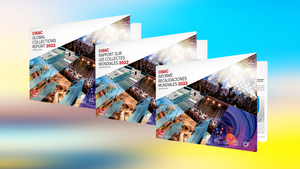Digital was the biggest revenue stream for the world's song right collecting societies for the first time last year, accounting for 37.7% of total collections. Royalties paid by broadcasters - previously the biggest revenue stream - accounted for 32.8% of collections in 2022.
This is according to the latest 'Global Collections Report' from CISAC, the global grouping for song right collecting societies. It aggregates revenue data from the collecting societies that represent songwriters and music publishers, so the likes of PRS in the UK, Sacem in France, BMI and ASCAP in the US, and so on.
Total collections across all the societies last year were up 28% to €10.8 billion. The live and public performance of music was the third biggest revenue stream, accounting for 23.2% of collections, with publishing royalties from physical products and the good old private copy levy generating much of the rest of the money.
The songs side of the music rights business was impacted more by the COVID-19 pandemic than the record industry because the live and public performance of music is a key revenue stream, and it obviously collapsed as the lockdowns went into effect. Broadcast revenues were also hit as the advertising sector wobbled, although - in the end - not as badly as expected.
All of which made digital a bigger deal during that period, with subscription streaming the one music revenue stream not really impacted by COVID at all, as subscriptions and revenues continued the grow throughout the pandemic.
That growth continues. Total digital revenues recorded by CISAC were up 33.5% to €4.1 billion last year as the streaming services continued to add more subscribers, plus some new and better licensing deals were secured by some societies.
It's also important to remember that not all digital income on the songs side flows through the collective licensing system. Many publishers license some catalogue - especially Anglo-American repertoire - through direct deals.
For technical reasons, some of that revenue is captured in the CISAC figures, but not all of it. And in the US, the mechanical royalties paid by streaming services via the MLC are not included either. So total digital income for songwriters and publishers is higher than what is reported in the 'Global Collections Report'.
Nevertheless, despite the growth, songwriters and publishers still generally feel they are not seeing enough value from the ongoing streaming boom. CISAC notes: "Digital music royalties to creators continue to substantially underperform in the wider context. Even at a record 37.7%, digital’s share of the total market is well below the corresponding share - 71% - for the recording industry".
In terms of live and public performance - the revenue stream most hit by COVID - income surged again in 2022 as the live sector resumed business, with a 68.2% increase in collections to €2.5 billion.
Though that is still 7.7% below pre-pandemic levels. CISAC reported that the speed with which live music returned differed greatly around the world, with bigger markets that have sizeable festival sectors seeing the highest growth rates.
Commenting on the new report, CISAC Director General Gadi Oron says: “This is a remarkable return to growth as our whole sector fully recovers from the disastrous three year pandemic".
"While live and public performance have bounced back strongly", he goes on, "the recovery is driven most of all by digital which has now become creators’ largest source of income. Streaming and subscription have not just revived the status quo, they have transformed the market, changed the game for creators and paved the way for future growth”.
In the report itself, CISAC President Björn Ulvaeus writes: “This year’s results show that the collective management system, despite all the enormous challenges it faces in adapting to digital, is still robust and effective. [Collecting societies] have the backs of the creators they serve and are now delivering more money to more creators than ever before".
"And that is good news", he continues, before looking ahead to the future and adding "because, fresh from COVID and the economic squeeze, what we now face is another very serious, existential challenge - that of artificial intelligence. AI will radically change the world for creators and the creative industry. It demands international leadership and a strong united front from all parts of the creative industry”.

